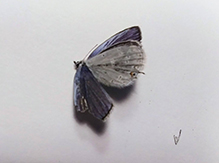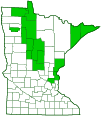western tailed-blue
(Cupido amyntula)
Conservation • Description • Habitat • Ecology • Distribution • Taxonomy
|
|
||||||||||||||
Description |
Western tailed-blue is a small to medium-sized butterfly. It is one of seven “blues” and one of two “tailed blues” in Minnesota. Western tailed-blue occurs in the United States west of the Great Plains, in Minnesota and northwestern Wisconsin, and in northern Maine. It also occurs in Alaska. In Canada it occurs from British Columbia and Yukon, east to Ontario, and there is an isolated (disjunct) population in New Brunswick and eastern Quebec. Adults are active from late May to mid-July in Minnesota. They are found mostly in forest openings with legumes, but also at forest edges, in meadows and prairies, and on roadsides. They feed on flower nectar, and they have also been seen visiting horse manure, coyote dung, urine, and mud. The larvae are found on legumes that have inflated seedpods, including milkvetches (Astragalus spp.), sweet peas and vetchlings (Lathyrus spp.), locoweed (Oxytropis spp.), and vetches (Vicia spp.). They feed on the young seeds. Adults have a ⅞″ to 1⅛″ (22 to 29 mm) wingspan. The forewing length is 7⁄16″ to 9⁄16″ (11 to 14 mm). On the male, the upperside of the wings is medium blue or dark blue, with a brown border on the outer margin and a white fringe. There is usually a broad, pale area along the basal half of the leading edge (costal margin). The underside of the forewing is chalky white with a thin black border on the outer margin and a marginal row of black eyespots. There are several additional black marks bordered with white, including a postmedial row of black dots or dashes, and a short, horizontal, medial stripe. Many or most of the black marks are faint, especially the marginal eyespots and the medial stripes. There are usually no orange spots on the upperside of the forewing. The hindwing is similarly marked, but it has a single hair-like tail near the middle of the outer margin. The postmedial row of spots is strongly arced in the middle, and there are three medial spots. One of the eyespots near the tail is capped with orange, and the adjacent spot is sometimes partially capped. There is no blue eyespot near the outer angle. The tail from one of the wings is sometimes missing, having been lost to a predator. The female wings are dark brown or blackish brown above with blue shading near the base. |
Size |
Wingspan: ⅞″ to 1⅛″ (22 to 29 mm) |
Similar Species |
Eastern tailed-blue (Cupido comyntas) wing underside is darker, the black markings are bolder, and the medial stripe is distinct. The hindwing usually has two orange-capped eyespots, and the adjacent (third) eyespot is often partially capped. The female usually has no blue on the upperside of the wings near the base. |
Habitat |
Mostly forest openings but also forest edges, meadows, prairies, and roadsides |
Ecology |
Season |
One generation per year in the north: Late May to mid-July |
Behavior |
|
Life Cycle |
The female lays usually three eggs on a young legume seedpod. When the eggs hatch, the larvae bore into the seedpod and seal the opening with silk. They complete their development and pupate within the seedpod. The pupae overwinter in the pod and the adults emerge in the following spring. According to one source, the larvae produce honeydew and are attended by ants. They apparently seal the opening in the pod only when ready to pupate. |
Larva Hosts |
Milkvetches (Astragalus spp.), sweet peas and vetchlings (Lathyrus spp.), locoweed (Oxytropis spp.), and vetches (Vicia spp.) |
Adult Food |
Flower nectar |
Distribution |
||
|
Sources |
|
| 5/26/2024 | ||
Occurrence |
||
Common to abundant but declining in the west in recent decades. Continuing to decline in recent years. |
||
Taxonomy |
|
Order |
|
Superfamily |
Papilionoidea (Butterflies) |
Family |
Lycaenidae (Gossamer-winged Butterflies) |
Subfamily |
Polyommatinae (blues) |
Tribe |
Polyommatini (typical blues) |
Subtribe |
Everina |
Genus |
Cupido (tailed blues) |
GBIF and Catalog of Life (CoL) place the North American “tailed blues” in the genus Elkalyce. No source for this change can be found. CoL lists the Nomenclature Status of Elkalyce amyntula as “potentially valid.” |
|
Subordinate Taxa |
|
Albright’s tailed-blue (Cupido amyntula albrighti) western tailed-blue (Cupido amyntula amyntula) western tailed-blue (Cupido amyntula arizonensis) western tailed-blue (Cupido amyntula dodgei) western tailed-blue (Cupido amyntula herrii) western tailed-blue (Cupido amyntula montanorum) western tailed-blue (Cupido amyntula nesiotes) western tailed-blue (Cupido amyntula valeriae) |
|
Synonyms |
|
Elkalyce amyntula Everes amyntula Lycaena amyntula |
|
Common Names |
|
western tailed-blue |
|
Glossary
Costal margin
The leading edge of the forewing of insects.
Visitor Photos |
||
Share your photo of this insect. |
||
This button not working for you? |
||
Luciearl |
||
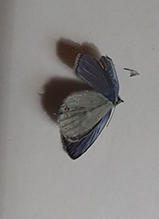 |
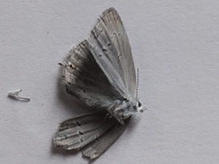 |
|
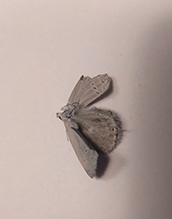 |
||
MinnesotaSeasons.com Photos |
||
|
||
|
||

Slideshows |
|

Visitor Videos |
||
Share your video of this insect. |
||
This button not working for you? |
||
|
Other Videos |
||
How to Identify Western Tailed Blue Mudpuddling |
About
Jun 8, 2020 This video highlights important field marks for identifying a Western Tailed-Blue (Everes amyntula). There are about 31 species of "Blues" (butterflies of the subfamily Polyommatinae) in North America. All are small with wingspans around an inch. And all are blue (females have brownish tones) on the upperwing. Separation and identification of species is accomplished by observing subtle markings on the underwing. Males of multiple species are known for gathering at moist soil sites to ingest minerals for breeding purposes - a perfect opportunity for study and contrast. |
Western Tailed Blue - Butterfly Watching |
About
Mar 2, 2023 Western Tailed-Blue (Everes amyntula) is a small (1-1.25" wingspan) butterfly. Found primarily in the American West. Pyle (2002) notes these butterflies use habitats that are on the wet side e.g. meadows, seeps, stream corridors. Glassberg (2017) outlines flight season as March/April through August; it is common/uncommon in its range. These butterflies utilize wildflowers of the Pea family as larval hosts (James and Nunnallee 2011). Adult males attend mud puddles; both sexes come to flowers for nectar. |

|
Created: 5/26/2024 Last Updated: © MinnesotaSeasons.com. All rights reserved. |
